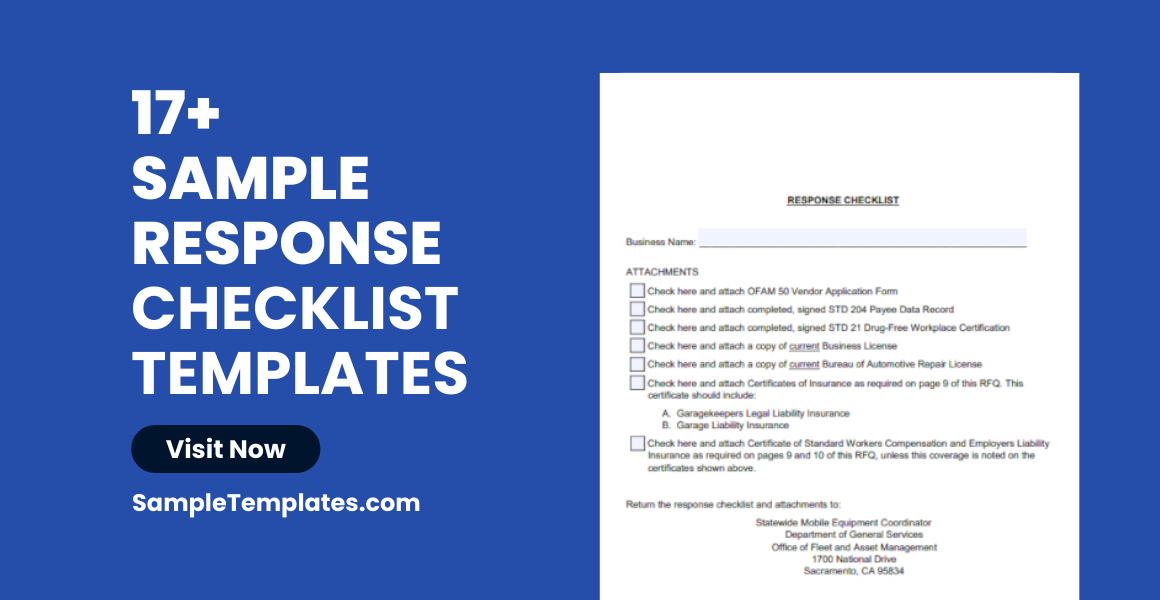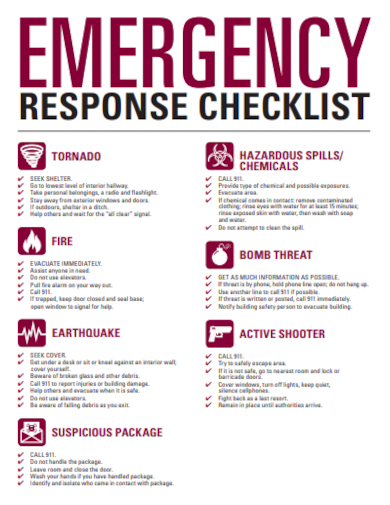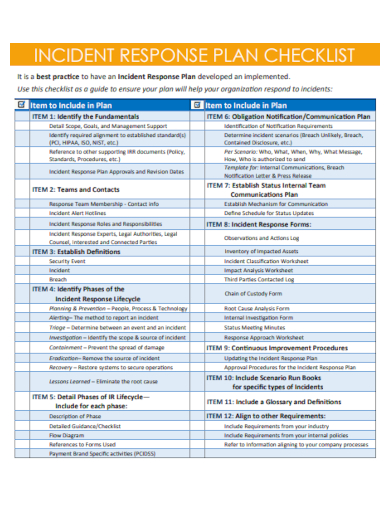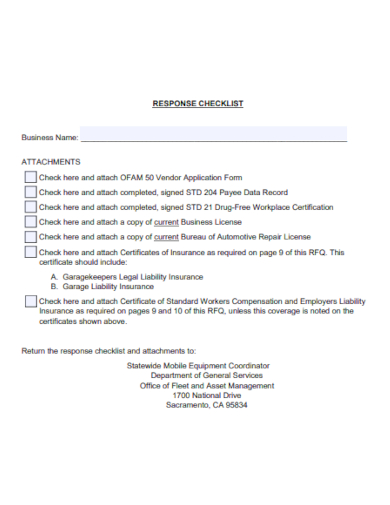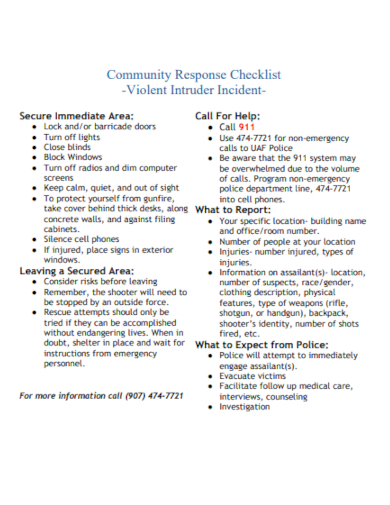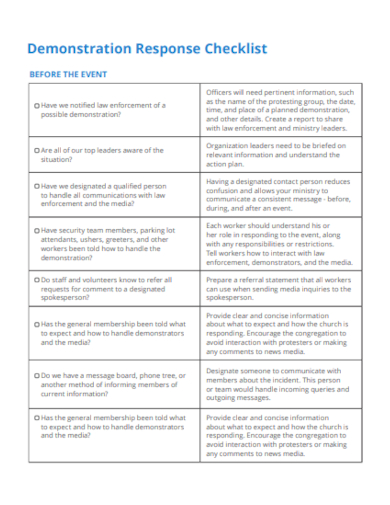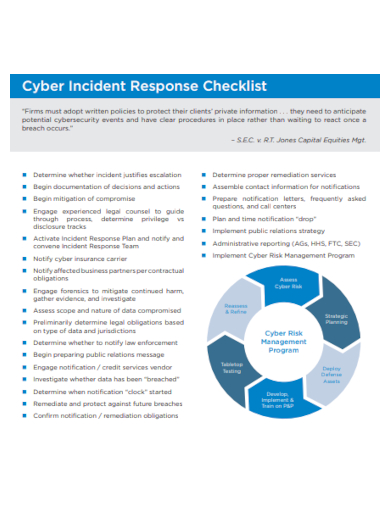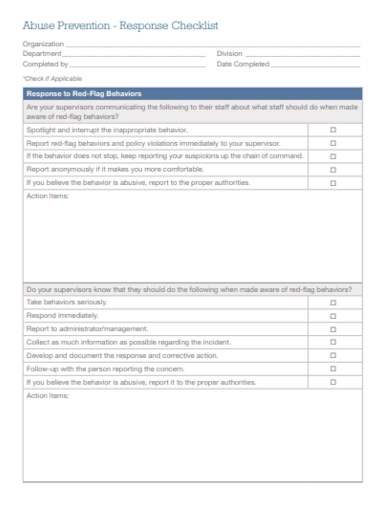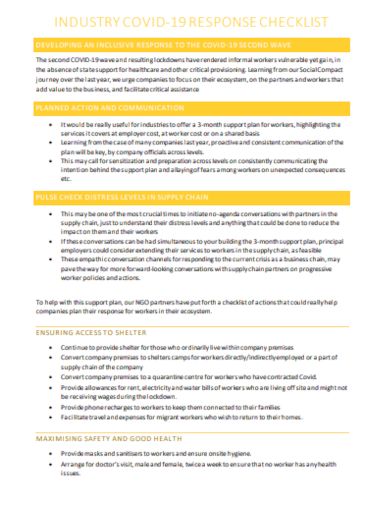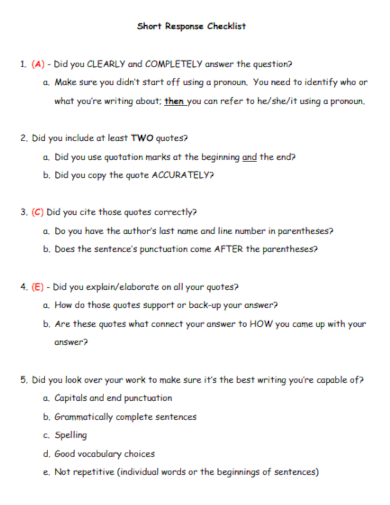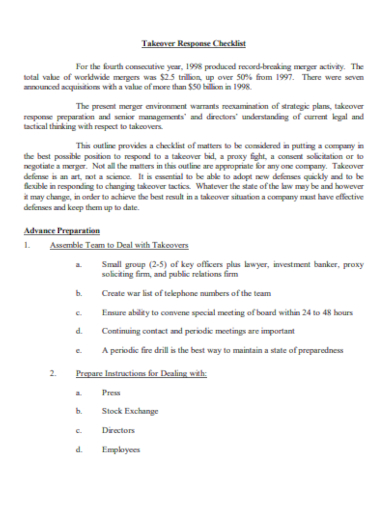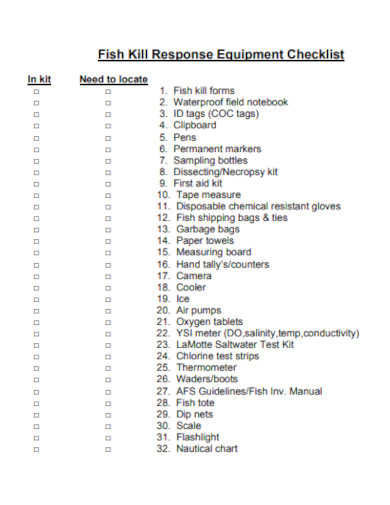Navigating the maze of modern-day interactions requires more than just intuition; it demands precision and timeliness. Enter the ‘Response Checklist.’ It’s not just a sample list; it’s your ally in the world of effective communication. Crafted meticulously for those who seek clarity in their responses, this tool is designed to elevate your approach, ensuring every reply is thoughtful and impactful. Unearth the secret to mastering responsiveness in our intricate digital landscape.
17+ Response Checklist Samples
1. Sample IT Incident Response Checklist

2. Sample Checklist Template
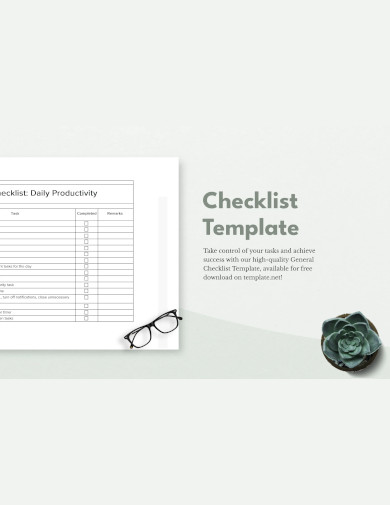
3. Basic Checklist Template
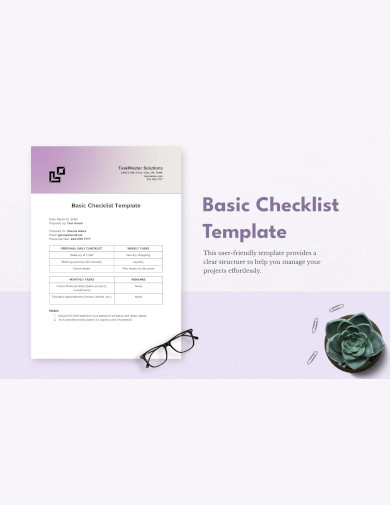
4. Formal Checklist Template
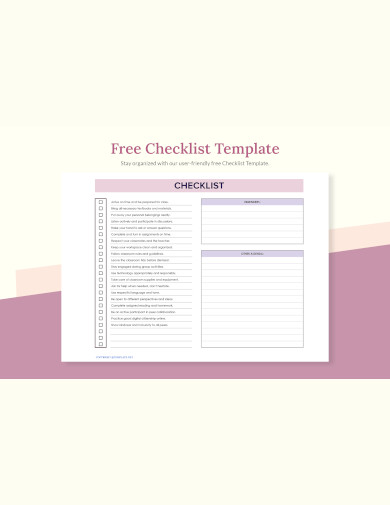
5. Printable Checklist Template
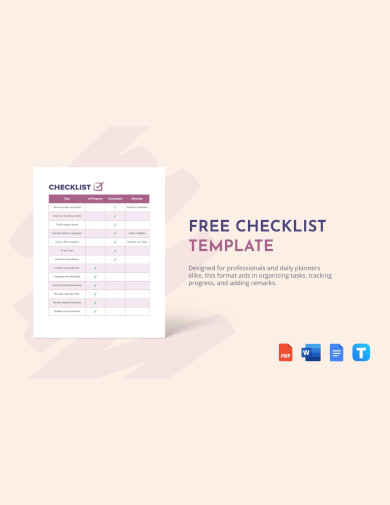
What is a Response Checklist?
In our rapidly-evolving professional landscape, being prepared for unexpected scenarios is a cornerstone of effective management. One tool that has gained traction in various industries for its efficacy in ensuring organized and timely reactions to sample events is the “Response Checklist.” But what exactly is this tool, and how does it serve its users?
Understanding the Basics
At its core, a Response Checklist is a pre-prepared list designed to guide individuals or teams through specific actions they should take in response to an event or situation. Much like a pilot’s pre-flight sample checklist ensures that all systems are operational and safe before taking off, a Response Checklist aims to eliminate oversights and ensure consistent, effective reactions in times of need.
The Value of Preparedness
The real value of a Response Checklist lies in its ability to simplify complex processes. In times of crisis or when under pressure, it’s natural for individuals to miss out on crucial steps or become overwhelmed. A printable checklist acts as an anchor, ensuring that all essential steps are taken, even under duress. For instance, in a medical emergency, healthcare professionals often resort to checklists to ensure they don’t overlook any vital intervention.
Diverse Applications
The beauty of Response Checklists is that they can be adapted to almost any scenario or industry. From IT, where teams might use them to respond to system outages, to hospitality, where they can guide staff through procedures when a guest has a complaint – the format applications are limitless. The primary aim remains the same: provide a clear, step-by-step guide to ensure the best possible outcome.
Building an Effective Response Checklist
- Identify Scenarios: Start by determining the situations where a checklist might be needed. This involves understanding potential challenges or crises your team or business might face.
- Involve Relevant Stakeholders: For the checklist to be effective, it’s essential to involve individuals who have expertise in the concerned area. They will provide insights that might not be obvious to others.
- Prioritize Steps: Not all steps in a checklist hold the same weight. It’s crucial to sequence them in order of importance or chronology to ensure smooth execution.
- Review and Revise: The first draft of your checklist shouldn’t be your last. Regularly revisiting and revising your checklist ensures it remains relevant and effective.
Response Checklists are used across various sectors and industries:
- Healthcare: Medical professionals may use them during emergencies to ensure that all critical interventions are performed.
- Aviation: Pilots employ checklists for various flight phases, from pre-flight inspections to emergency procedures.
- IT: Teams might have checklists for handling server outages, data breaches, or system updates.
- Hospitality: Such checklists can guide staff on how to handle specific guest complaints or situations.
- Disaster Response: Emergency response teams may use checklists to ensure they address all necessary areas after a natural disaster. You can also see more templates like Incident Checklist Samples.
Importance of a Response Checklist
A Response Checklist is more than just a sequential list of tasks. It’s a vital tool that brings organization, clarity, and efficiency to situations that often require immediate and precise action. Understanding its importance can shed light on why many industries and organizations adopt such checklists as a standard practice. Here’s a breakdown of the significance of a Response Checklist:
- Ensures Consistency: One of the primary advantages of a Response Checklist is that it ensures a consistent approach every time a specific situation arises. Whether it’s a medical procedure, IT troubleshooting, or emergency response, the same set of actions will be taken, thereby ensuring uniformity in response.
- Reduces Human Error: Under stress or in high-pressure scenarios, even experienced professionals can forget or overlook essential steps. A Response Checklist acts as a safety net, minimizing the chances of mistakes and omissions.
- Streamlines Decision-making: In critical situations, timely decisions can make a vast difference. With a predefined set of actions to follow, individuals can act quickly without wasting time deliberating on the next course of action.
- Enhances Training: For new recruits or staff members, a Response Checklist can serve as a foundational training tool. It provides a clear sample outline of what’s expected in specific scenarios, helping to standardize training processes.
- Facilitates Continuous Improvement: After using a Response Checklist in a real-world scenario, teams can evaluate its effectiveness and make necessary adjustments. This iterative process ensures that the checklist remains relevant and evolves with changing circumstances or new insights.
- Boosts Confidence: Knowing that there’s a sample plan in place can significantly boost the confidence of individuals tasked with handling challenging situations. It can alleviate anxiety and enable more focused, decisive action.
- Saves Time: By eliminating the need for on-the-spot brainstorming or debate, a checklist can expedite responses. This is especially vital in emergencies where every second count.
- Promotes Accountability: With a set list of actions, it becomes easier to track which steps were taken and by whom. This can be useful for post-event evaluations and in instances where accountability is required.
- Enhances Communication: In team-based environments, a Response Checklist can serve as a communication tool. It ensures everyone is on the same page and has a clear understanding of their roles and responsibilities.
- Compliance and Regulation: In some industries, adhering to specific procedures is not just best practice but a regulatory requirement. A Response Checklist can help ensure compliance with these standards.
Benefits of Implementing a Response Checklist
- Standardization: With a standardized checklist, there’s a guarantee that every team member responds to a situation in a consistent manner, ensuring uniformity.
- Reduction of Errors: In stressful or fast-paced situations, it’s easy for steps to be overlooked. A checklist mitigates this risk, ensuring nothing falls through the cracks.
- Efficiency and Time-saving: When everyone knows the steps they need to take, decision-making becomes swifter, and the response is more efficient.
- Training Tool: For newcomers or those unfamiliar with a procedure, the checklist acts as a training guide, ensuring they understand the required steps.
- Legal and Compliance Standing: In many industries, having documented procedures (like checklists) can be crucial from a legal and compliance standpoint.
Challenges and Common Mistakes
While Response Checklists are invaluable, it’s also essential to be wary of pitfalls:
- Over-reliance: While checklists are great tools, they can’t replace critical thinking. Situations may sometimes demand flexibility and judgment beyond the checklist.
- Stagnation: Failing to regularly update checklists can render them obsolete, especially in rapidly changing fields.
- Over-complication: A checklist that’s too long or complex can be daunting and counterproductive. You can also see more templates like Performance Checklist Samples.
6. Sample Emergency Response Checklist Template
7. Sample Aircraft Response Checklist Template
8. Sample Response Plan Checklist Template
9. Sample Vendor Response Checklist Template
10. Sample Community Response Checklist Template
11. Sample Demonstration Response Checklist Template
12. Sample Cyber Incident Response Checklist Template
13. Sample Abuse Prevention Response Checklist Template
14. Sample COVID-19 Response Checklist Template
15. Sample Short Response Checklist Template
16. Sample Takeover Response Checklist Template
17. Sample Response Event Checklist Template
18. Sample Response Equipment Checklist Template
How to Create a Response Checklist?
Whether you’re managing a team, running a business, or simply organizing your day-to-day tasks, having a response checklist can be invaluable. This tool can streamline your processes, ensure you don’t miss crucial steps, and provide clarity in times of chaos. You can also see more templates like Monthly Checklist Samples. Here’s a step-by-step guide to creating a robust response checklist:
1. Define Your Objective
Before you dive into creating a checklist, you must understand its purpose. Are you designing a checklist for emergency responses? Is it for processing customer inquiries? Or perhaps for daily routines in a specific job role?
For example, if you’re creating a checklist for handling customer complaints in a restaurant setting, your sample objective might be: “To ensure every customer complaint is addressed promptly, professionally, and to the customer’s satisfaction.”
2. Brainstorm & List Down All Potential Tasks
Once you’ve defined your objective, list down all the potential tasks or steps that need to be taken to achieve it. It’s advisable to involve team members or stakeholders who will be using the checklist, as they might offer crucial insights.
Using our restaurant example:
- Listen actively to the customer’s complaint.
- Apologize sincerely.
- Record the details of the complaint.
- Decide on an immediate action.
- Follow-up with the customer after the resolution.
3. Organize & Prioritize
With your list of tasks in hand, it’s time to organize them in a logical sequence. Some tasks might be dependent on others, so ordering them correctly is crucial. Also, certain tasks might be more urgent or important than others; make sure they’re prominently placed.
In the case of our restaurant scenario:
- Listen actively and apologize (sets a positive tone).
- Record the details (ensures nothing is missed).
- Decide on an immediate action (addresses the issue).
- Follow-up (shows commitment to customer satisfaction).
4. Review & Refine
Once you have your initial draft, review the sample checklist. Test it out in real or simulated scenarios to see if it covers everything and if the flow is natural. Adjust based on feedback. This step might require several iterations, especially as you discover unforeseen complexities or redundancies.
For the restaurant: After using the checklist for a week, you might find that a step for “training staff on common complaints” might be a proactive addition.
5. Implement, Monitor, & Update
When you’re satisfied with your checklist, it’s time to implement it. Distribute it to relevant personnel or teams and provide training if necessary. It’s essential to monitor the checklist’s effectiveness and gather a sample feedback regularly. As your processes evolve, so should your checklist. Periodically updating it ensures it remains relevant and effective.
Back to our example: Maybe after a month, the restaurant finds out that a new dish is causing multiple complaints. It might be a good idea to update the checklist with a “Check for common complaint trends monthly” step.
What is an Incident Response Checklist?
An Incident Response (IR) Checklist is a structured tool used by organizations to guide their approach to identifying, responding to, and recovering from security incidents. Such checklists play a crucial role in cybersecurity and IT management, ensuring that every potential threat or breach is addressed systematically and comprehensively.
In Conclusion, a Response Checklist is more than just a list; it’s a tool for consistency, effectiveness, and peace of mind. Whether you’re looking to streamline procedures in a corporate setting or ensure safety in high-pressure environments, such checklists can be invaluable assets. Like all tools, their real power lies in how they’re crafted and used – making it essential to invest time in their creation and continual refinement. You can also see more templates like Investigation Checklist Samples.
Related Posts
FREE 18+ Internship Checklist Samples in MS Word | Google Docs | PDF
FREE 18+ Statement Checklist Samples in MS Word | Google Sheets | PDF
FREE 20+ Voluntary Checklist Samples in MS Word | Google Sheets | PDF
FREE 18+ Summary Checklist Samples in MS Word | Google Sheets | PDF
FREE 14+ Sponsorship Checklist Samples in MS Word | MS Excel | PDF
FREE 18+ Conference Checklist Samples in MS Word | Google Sheets | PDF
FREE 17+ Lesson Checklist Samples in MS Word | Google Sheets | PDF
FREE 18+ Progress Checklist Samples in MS Word | Google Docs | PDF
FREE 18+ Enrollment Checklist Samples in MS Word | Google Docs | PDF
FREE 18+ Graduation Checklist Samples in MS Word | Google Sheets | PDF
FREE 15+ Consent Checklist Samples in MS Word | Google Sheets | PDF
FREE 18+ Review Checklist Samples in MS Word | Apple Pages | PDF
FREE 18+ Submission Checklist Samples in MS Word | Google Docs | PDF
FREE 18+ Request Checklist Samples in MS Word | MS Excel | PDF
FREE 21+ Faculty Checklist Samples in MS Word | Google Sheets | PDF
